Urban Spatial Management and Planning Based on the Interactions Between Ecosystem Services: A Case Study of the Beijing–Tianjin–Hebei Urban Agglomeration
Abstract
1. Introduction
2. Materials and Methods
2.1. Study Area
2.2. Data Source
2.3. Research Framework
2.4. Assessment of Ecosystem Services
2.4.1. Food Production (FP)
2.4.2. Carbon Storage (CS)
2.4.3. Water Yield (WY)
2.4.4. Soil Conservation (SC)
2.4.5. Habitat Quality (HQ)
2.4.6. Ecosystem Service Index
2.5. Identification of Trade-Offs/Synergies Between ESs
2.5.1. Correlation Analysis
2.5.2. Geographically Weighted Regression
2.6. Identification of ES Drivers
2.7. Identification of ES Bundles
3. Results
3.1. Spatial and Temporal Distribution Patterns of ESs
3.2. Land Use Change Patterns
3.3. Trade-Offs and Synergies Among ESs
3.4. ES Bundle Characteristics and Distribution
3.5. Impacts of Driving Factors on ESs
- (a)
- FP was mainly driven by precipitation, FVC, and the cropland area ratio. The effects of all three drivers weakened across time, but the effects of nightlight, population density, and the forest area ratio increased.
- (b)
- CS was mainly driven by forest area, grassland area, and cropland area ratios. The degree of the influence of grassland increased over time, while the effect of the cropland area ratio was inversely related to time.
- (c)
- In 2000, the dominant drivers for WY were precipitation and cropland area and forest area ratios, while in 2020, the dominant drivers were precipitation and impervious area and forest area ratios. Over the 20-year period, the InMSE for the impervious area ratio increased by 54.80%.
- (d)
- SC was driven by precipitation, DGP, and the forest area ratio in 2000, which was the same in 2020. In particular, the influence of precipitation decreased over time, while the impact of the other two factors increased.
- (e)
- The impact of all ten drivers on HQ was more pronounced, but the primary drivers were the impervious area ratio, FVC, and precipitation. Additionally, the influence of landscape factors (particularly the impervious area ratio) on HQ increased significantly.
- (f)
- ESs were primarily driven by precipitation, FVC, and the cropland area ratio. From 2000 to 2020, the contribution of precipitation, population density, and grassland area and impervious area ratios showed an increasing trend, with the precipitation InMSE increasing by 78.72%.
4. Discussion
4.1. The Characteristics and Distributions of ES Interactions
4.2. Potential Driving Mechanisms of ESs
4.3. Spatial Planning and Management Strategies
4.4. Limitations
5. Conclusions
Supplementary Materials
Author Contributions
Funding
Data Availability Statement
Conflicts of Interest
References
- Millennium Ecosystem Assessment (MEA). Ecosystems and Human Wellbeing: Synthesis; Island Press: Washington, DC, USA, 2005. [Google Scholar]
- Costanza, R.; Grasso, M.; Hannon, B.; Limburg, K.; Naeem, S.; O’Neill, R.V.; Paruelo, J.; Raskin, R.G.; Sutton, P. The Value of the World’s Ecosystem Services and Natural Capital. Ecol. Econ. 1998, 25, 3–15. [Google Scholar]
- Liu, Y.; Xia, C.; Ou, X.; Lv, Y.; Ai, X.; Pan, R.; Zhang, Y.; Shi, M.; Zheng, X. Quantitative Structure and Spatial Pattern Optimization of Urban Green Space from the Perspective of Carbon Balance: A Case Study in Beijing, China. Ecol. Indic. 2023, 148, 110034. [Google Scholar] [CrossRef]
- Yang, J.; Duan, C.; Wang, H.; Chen, B. Spatial Supply-Demand Balance of Green Space in the Context of Urban Waterlogging Hazards and Population Agglomeration. Resour. Conserv. Recycl. 2023, 188, 106662. [Google Scholar] [CrossRef]
- Vihervaara, P.; Rönkä, M.; Walls, M. Trends in Ecosystem Service Research: Early Steps and Current Drivers. AMBIO 2010, 39, 314–324. [Google Scholar] [CrossRef]
- Ai, X.; Zheng, X.; Zhang, Y.; Liu, Y.; Ou, X.; Xia, C.; Liu, L. Climate and Land Use Changes Impact the Trajectories of Ecosystem Service Bundles in an Urban Agglomeration: Intricate Interaction Trends and Driver Identification under SSP-RCP Scenarios. Sci. Total Environ. 2024, 944, 173828. [Google Scholar] [CrossRef]
- Ouyang, X.; Tang, L.; Wei, X.; Li, Y. Spatial Interaction between Urbanization and Ecosystem Services in Chinese Urban Agglomerations. Land Use Policy 2021, 109, 105587. [Google Scholar] [CrossRef]
- Li, T.; Jia, B.; Zhang, Q.; Liu, W.; Fang, Y. Scenario Simulation of Urban Land Use and Ecosystem Service Coupling Major Function-Oriented Zoning. Ecosyst. Health Sustain. 2024, 10, 0078. [Google Scholar] [CrossRef]
- Li, S.; Yang, H.; Liu, J.; Lei, G. Towards Ecological-Economic Integrity in the Jing-Jin-Ji Regional Development in China. Water 2018, 10, 1653. [Google Scholar] [CrossRef]
- Behboudian, M.; Anamaghi, S.; Mahjouri, N.; Kerachian, R. Enhancing the Resilience of Ecosystem Services under Extreme Events in Socio-Hydrological Systems: A Spatio-Temporal Analysis. J. Clean. Prod. 2023, 397, 136437. [Google Scholar] [CrossRef]
- Yang, Q.; Liu, G.; Casazza, M.; Dumontet, S.; Yang, Z. Ecosystem Restoration Programs Challenges under Climate and Land Use Change. Sci. Total Environ. 2022, 807, 150527. [Google Scholar] [CrossRef]
- Ouyang, Z.; Wang, X.; Miao, H. A Primary Study on Chinese Terrestrial Ecosystem Services and Their Ecological-Economic Values. Acta Ecol. Sin. 1999, 19, 607–613. [Google Scholar]
- Jiang, W.; Wu, T.; Fu, B. The Value of Ecosystem Services in China: A Systematic Review for Twenty Years. Ecosyst. Serv. 2021, 52, 101365. [Google Scholar] [CrossRef]
- Xie, G.; Zhang, C.; Zhen, L.; Zhang, L. Dynamic Changes in the Value of China’s Ecosystem Services. Ecosyst. Serv. 2017, 26, 146–154. [Google Scholar] [CrossRef]
- Yang, M.; Chen, Y.; Yang, Y.; Yan, Y. Nonlinear Relationship and Threshold-Based Zones between Ecosystem Service Supply-Demand Ratio and Land Use Intensity: A Case Study of the Beijing-Tianjin-Hebei Region, China. J. Clean. Prod. 2024, 481, 144148. [Google Scholar] [CrossRef]
- Braun, D.; de Jong, R.; Schaepman, M.E.; Furrer, R.; Hein, L.; Kienast, F.; Damm, A. Ecosystem Service Change Caused by Climatological and Non-Climatological Drivers: A Swiss Case Study. Ecol. Appl. 2019, 29, e01901. [Google Scholar] [CrossRef]
- Reader, M.O.; Eppinga, M.B.; de Boer, H.J.; Damm, A.; Petchey, O.L.; Santos, M.J. Biodiversity Mediates Relationships between Anthropogenic Drivers and Ecosystem Services across Global Mountain, Island and Delta Systems. Glob. Environ. Change 2023, 78, 102612. [Google Scholar] [CrossRef]
- Shen, J.; Li, S.; Wang, H.; Wu, S.; Liang, Z.; Zhang, Y.; Wei, F.; Li, S.; Ma, L.; Wang, Y.; et al. Understanding the Spatial Relationships and Drivers of Ecosystem Service Supply-Demand Mismatches towards Spatially-Targeted Management of Social-Ecological System. J. Clean. Prod. 2023, 406, 136882. [Google Scholar] [CrossRef]
- Dade, M.C.; Mitchell, M.G.E.; McAlpine, C.A.; Rhodes, J.R. Assessing Ecosystem Service Trade-Offs and Synergies: The Need for a More Mechanistic Approach. Ambio 2019, 48, 1116–1128. [Google Scholar] [CrossRef]
- Dou, H.; Li, X.; Li, S.; Dang, D.; Li, X.; Lyu, X.; Li, M.; Liu, S. Mapping Ecosystem Services Bundles for Analyzing Spatial Trade-Offs in Inner Mongolia, China. J. Clean. Prod. 2020, 256, 120444. [Google Scholar] [CrossRef]
- Queiroz, C.; Meacham, M.; Richter, K.; Norström, A.V.; Andersson, E.; Norberg, J.; Peterson, G. Mapping Bundles of Ecosystem Services Reveals Distinct Types of Multifunctionality within a Swedish Landscape. AMBIO 2015, 44, 89–101. [Google Scholar] [CrossRef]
- Li, Z.; Cheng, X.; Han, H. Analyzing Land-Use Change Scenarios for Ecosystem Services and Their Trade-Offs in the Ecological Conservation Area in Beijing, China. Int. J. Environ. Res. Public Health 2020, 17, 8632. [Google Scholar] [CrossRef] [PubMed]
- Xu, W.; Xu, H.; Li, X.; Hua, Q.; Wang, Z. Ecosystem Services Response to Future Land Use/Cover Change (LUCC) under Multiple Scenarios: A Case Study of the Beijing-Tianjin-Hebei (BTH) Region, China. Technol. Forecast. Soc. Change 2024, 205, 123525. [Google Scholar] [CrossRef]
- Shen, J.; Li, S.; Liu, L.; Liang, Z.; Wang, Y.; Wang, H.; Wu, S. Uncovering the Relationships between Ecosystem Services and Social-Ecological Drivers at Different Spatial Scales in the Beijing-Tianjin-Hebei Region. J. Clean. Prod. 2021, 290, 125193. [Google Scholar] [CrossRef]
- Xia, H.; Yuan, S.; Prishchepov, A.V. Spatial-Temporal Heterogeneity of Ecosystem Service Interactions and Their Social-Ecological Drivers: Implications for Spatial Planning and Management. Resour. Conserv. Recycl. 2023, 189, 106767. [Google Scholar] [CrossRef]
- Mitchell, M.G.E.; Qiu, J.; Cardinale, B.J.; Chan, K.M.A.; Eigenbrod, F.; Felipe-Lucia, M.R.; Jacob, A.L.; Jones, M.S.; Sonter, L.J. Key Questions for Understanding Drivers of Biodiversity-Ecosystem Service Relationships across Spatial Scales. Landsc. Ecol. 2024, 39, 36. [Google Scholar] [CrossRef]
- Wang, Y.; Dai, E. Spatial-Temporal Changes in Ecosystem Services and the Trade-off Relationship in Mountain Regions: A Case Study of Hengduan Mountain Region in Southwest China. J. Clean. Prod. 2020, 264, 121573. [Google Scholar] [CrossRef]
- Zhang, Z.; Peng, J.; Xu, Z.; Wang, X.; Meersmans, J. Ecosystem Services Supply and Demand Response to Urbanization: A Case Study of the Pearl River Delta, China. Ecosyst. Serv. 2021, 49, 101274. [Google Scholar] [CrossRef]
- Yang, Y.; Yuan, X.; An, J.; Su, Q.; Chen, B. Drivers of Ecosystem Services and Their Trade-Offs and Synergies in Different Land Use Policy Zones of Shaanxi Province, China. J. Clean. Prod. 2024, 452, 142077. [Google Scholar] [CrossRef]
- Bennett, E.M.; Cramer, W.; Begossi, A.; Cundill, G.; Díaz, S.; Egoh, B.N.; Geijzendorffer, I.R.; Krug, C.B.; Lavorel, S.; Lazos, E.; et al. Linking Biodiversity, Ecosystem Services, and Human Well-Being: Three Challenges for Designing Research for Sustainability. Open Issue 2015, 14, 76–85. [Google Scholar] [CrossRef]
- Mach, M.E.; Martone, R.G.; Chan, K.M.A. Human Impacts and Ecosystem Services: Insufficient Research for Trade-off Evaluation. Ecosyst. Serv. 2015, 16, 112–120. [Google Scholar] [CrossRef]
- Cord, A.F.; Bartkowski, B.; Beckmann, M.; Dittrich, A.; Hermans-Neumann, K.; Kaim, A.; Lienhoop, N.; Locher-Krause, K.; Priess, J.; Schröter-Schlaack, C.; et al. Towards Systematic Analyses of Ecosystem Service Trade-Offs and Synergies: Main Concepts, Methods and the Road Ahead. Ecosyst. Serv. 2017, 28, 264–272. [Google Scholar] [CrossRef]
- Deng, X.; Li, Z.; Gibson, J. A Review on Trade-off Analysis of Ecosystem Services for Sustainable Land-Use Management. J. Geogr. Sci. 2016, 26, 953–968. [Google Scholar] [CrossRef]
- Spake, R.; Lasseur, R.; Crouzat, E.; Bullock, J.M.; Lavorel, S.; Parks, K.E.; Schaafsma, M.; Bennett, E.M.; Maes, J.; Mulligan, M.; et al. Unpacking Ecosystem Service Bundles: Towards Predictive Mapping of Synergies and Trade-Offs between Ecosystem Services. Glob. Environ. Change 2017, 47, 37–50. [Google Scholar] [CrossRef]
- Raudsepp-Hearne, C.; Peterson, G.D.; Bennett, E.M. Ecosystem Service Bundles for Analyzing Tradeoffs in Diverse Landscapes. Proc. Natl. Acad. Sci. USA 2010, 107, 5242–5247. [Google Scholar] [CrossRef] [PubMed]
- Feng, Z.; Jin, X.; Chen, T.; Wu, J. Understanding Trade-Offs and Synergies of Ecosystem Services to Support the Decision-Making in the Beijing–Tianjin–Hebei Region. Land Use Policy 2021, 106, 105446. [Google Scholar] [CrossRef]
- Karimi, J.D.; Corstanje, R.; Harris, J.A. Understanding the Importance of Landscape Configuration on Ecosystem Service Bundles at a High Resolution in Urban Landscapes in the UK. Landsc. Ecol. 2021, 36, 2007–2024. [Google Scholar] [CrossRef]
- Zuo, L.; Gao, J. Investigating the Compounding Effects of Environmental Factors on Ecosystem Services Relationships for Ecological Conservation Red Line Areas. Land Degrad. Dev. 2021, 32, 4609–4623. [Google Scholar] [CrossRef]
- Li, Q.; Bao, Y.; Wang, Z.; Chen, X.; Lin, X. Trade-Offs and Synergies of Ecosystem Services in Karst Multi-Mountainous Cities. Ecol. Indic. 2024, 159, 111637. [Google Scholar] [CrossRef]
- Liu, S.; Wang, Z.; Wu, W.; Yu, L. Effects of Landscape Pattern Change on Ecosystem Services and Its Interactions in Karst Cities: A Case Study of Guiyang City in China. Ecol. Indic. 2022, 145, 109646. [Google Scholar] [CrossRef]
- Jaligot, R.; Chenal, J.; Bosch, M. Assessing Spatial Temporal Patterns of Ecosystem Services in Switzerland. Landsc. Ecol. 2019, 34, 1379–1394. [Google Scholar] [CrossRef]
- Yang, K.; Han, Q.; Vries, B.D. Urbanization Effects on the Food-Water-Energy Nexus within Ecosystem Services: A Case Study of the Beijing-Tianjin-Hebei Urban Agglomeration in China. Ecol. Indic. 2024, 160, 111845. [Google Scholar] [CrossRef]
- Mouchet, M.A.; Lamarque, P.; Martín-López, B.; Crouzat, E.; Gos, P.; Byczek, C.; Lavorel, S. An Interdisciplinary Methodological Guide for Quantifying Associations between Ecosystem Services. Glob. Environ. Change 2014, 28, 298–308. [Google Scholar] [CrossRef]
- Peng, J.; Hu, X.; Qiu, S.; Hu, Y.; Meersmans, J.; Liu, Y. Multifunctional Landscapes Identification and Associated Development Zoning in Mountainous Area. Sci. Total Environ. 2019, 660, 765–775. [Google Scholar] [CrossRef]
- Jopke, C.; Kreyling, J.; Maes, J.; Koellner, T. Interactions among Ecosystem Services across Europe: Bagplots and Cumulative Correlation Coefficients Reveal Synergies, Trade-Offs, and Regional Patterns. Ecol. Indic. 2015, 49, 46–52. [Google Scholar] [CrossRef]
- Chen, H.; Fleskens, L.; Schild, J.; Moolenaar, S.; Wang, F.; Ritsema, C. Impacts of Large-Scale Landscape Restoration on Spatio-Temporal Dynamics of Ecosystem Services in the Chinese Loess Plateau. Landsc. Ecol. 2022, 37, 329–346. [Google Scholar] [CrossRef]
- Jiang, C.; Zhang, H.; Zhang, Z. Spatially Explicit Assessment of Ecosystem Services in China’s Loess Plateau: Patterns, Interactions, Drivers, and Implications. Glob. Planet. Change 2018, 161, 41–52. [Google Scholar] [CrossRef]
- Keeler, B.L.; Hamel, P.; McPhearson, T.; Hamann, M.H.; Donahue, M.L.; Meza Prado, K.A.; Arkema, K.K.; Bratman, G.N.; Brauman, K.A.; Finlay, J.C.; et al. Social-Ecological and Technological Factors Moderate the Value of Urban Nature. Nat. Sustain. 2019, 2, 29–38. [Google Scholar] [CrossRef]
- Vialatte, A.; Barnaud, C.; Blanco, J.; Ouin, A.; Choisis, J.-P.; Andrieu, E.; Sheeren, D.; Ladet, S.; Deconchat, M.; Clément, F.; et al. A Conceptual Framework for the Governance of Multiple Ecosystem Services in Agricultural Landscapes. Landsc. Ecol. 2019, 34, 1653–1673. [Google Scholar] [CrossRef]
- Obiang Ndong, G.; Villerd, J.; Cousin, I.; Therond, O. Using a Multivariate Regression Tree to Analyze Trade-Offs between Ecosystem Services: Application to the Main Cropping Area in France. Sci. Total Environ. 2021, 764, 142815. [Google Scholar] [CrossRef]
- Wilkerson, M.L.; Mitchell, M.G.E.; Shanahan, D.; Wilson, K.A.; Ives, C.D.; Lovelock, C.E.; Rhodes, J.R. The Role of Socio-Economic Factors in Planning and Managing Urban Ecosystem Services. Ecosyst. Serv. 2018, 31, 102–110. [Google Scholar] [CrossRef]
- Dai, X.; Wang, L.; Huang, C.; Fang, L.; Wang, S.; Wang, L. Spatio-Temporal Variations of Ecosystem Services in the Urban Agglomerations in the Middle Reaches of the Yangtze River, China. Ecol. Indic. 2020, 115, 106394. [Google Scholar] [CrossRef]
- Xu, J.; Chen, J.; Liu, Y.; Fan, F. Identification of the Geographical Factors Influencing the Relationships between Ecosystem Services in the Belt and Road Region from 2010 to 2030. J. Clean. Prod. 2020, 275, 124153. [Google Scholar] [CrossRef]
- Li, S. The Dynamics of Ecosystem Services and Their Driving Factors in the Jing-Jin-Ji Region. Ph.D. Thesis, Beijing Forestry University, Beijing, China, 2019. [Google Scholar]
- Su, C.; Dong, M.; Fu, B.; Liu, G. Scale Effects of Sediment Retention, Water Yield, and Net Primary Production: A Case-study of the Chinese Loess Plateau. Land Degrad. Dev. 2020, 31, 1408–1421. [Google Scholar] [CrossRef]
- Ding, H.; Sun, R. Supply-Demand Analysis of Ecosystem Services Based on Socioeconomic and Climate Scenarios in North China. Ecol. Indic. 2023, 146, 109906. [Google Scholar] [CrossRef]
- Guo, W.; Teng, Y.; Yan, Y.; Zhao, C.; Zhang, W.; Ji, X. Simulation of Land Use and Carbon Storage Evolution in Multi-Scenario: A Case Study in Beijing-Tianjin-Hebei Urban Agglomeration, China. Sustainability 2022, 14, 13436. [Google Scholar] [CrossRef]
- The Population in Beijing-Tianjin-Hebei (2013–2023). Available online: https://view.officeapps.live.com/op/view.aspx?src=https%3A%2F%2Ftjj.beijing.gov.cn%2Fzt%2Fjjjjdzl%2Fsjcx_4303%2F202501%2FP020250106404611288605.xlsx&wdOrigin=BROWSELINK (accessed on 1 March 2025).
- Regional GDP by Industry and per Capita GDP in Beijing-Tianjin-Hebei (2013–2023). Available online: https://view.officeapps.live.com/op/view.aspx?src=https%3A%2F%2Ftjj.beijing.gov.cn%2Fzt%2Fjjjjdzl%2Fsjcx_4303%2F202501%2FP020250106406267184883.xlsx&wdOrigin=BROWSELINK (accessed on 1 March 2025).
- Yang, J.; Huang, X. The 30m Annual Land Cover Dataset and Its Dynamics in China from 1990 to 2019. Earth Syst. Sci. Data 2021, 13, 3907–3925. [Google Scholar] [CrossRef]
- Zhang, L.; Ren, Z.; Chen, B.; Gong, P.; Xu, B.; Fu, H. A Prolonged Artificial Nighttime-Light Dataset of China (1984-2020). Sci. Data 2024, 11, 414. [Google Scholar] [CrossRef]
- Peng, S.; Ding, Y.; Liu, W.; Li, Z. 1 Km Monthly Temperature and Precipitation Dataset for China from 1901 to 2017. Earth Syst. Sci. Data 2019, 11, 1931–1946. [Google Scholar] [CrossRef]
- Ding, Y.; Peng, S. Spatiotemporal Change and Attribution of Potential Evapotranspiration over China from 1901 to 2100. Theor. Appl. Climatol. 2021, 145, 79–94. [Google Scholar] [CrossRef]
- Groten, S.M.E. NDVI—Crop Monitoring and Early Yield Assessment of Burkina Faso. Int. J. Remote Sens. 1993, 14, 1495–1515. [Google Scholar]
- Deafalla, T.H.H.; Csaplovics, E.; El Abbas, M.M.; Deifalla, M.H.H. Spatial Distribution and Geosimulation of Non-Timber Forest Products for Food Security in Conflict Area. In The Climate-Conflict-Displacement Nexus from a Human Security Perspective; Behnassi, M., Gupta, H., Kruidbos, F., Parlow, A., Eds.; Springer International Publishing: Cham, Switzerland, 2022; pp. 225–250. ISBN 978-3-030-94144-4. [Google Scholar]
- Liu, X.; Wei, M.; Li, Z.; Zeng, J. Multi-Scenario Simulation of Urban Growth Boundaries with an ESP-FLUS Model: A Case Study of the Min Delta Region, China. Ecol. Indic. 2022, 135, 108538. [Google Scholar] [CrossRef]
- Chu, X.; Zhan, J.; Li, Z.; Zhang, F.; Qi, W. Assessment on Forest Carbon Sequestration in the Three-North Shelterbelt Program Region, China. J. Clean. Prod. 2019, 215, 382–389. [Google Scholar] [CrossRef]
- Zhang, D.; Zuo, X.; Zang, C. Assessment of Future Potential Carbon Sequestration and Water Consumption in the Construction Area of the Three-North Shelterbelt Programme in China. Agric. For. Meteorol. 2021, 303, 108377. [Google Scholar] [CrossRef]
- Dittrich, A.; Seppelt, R.; Václavík, T.; Cord, A.F. Integrating Ecosystem Service Bundles and Socio-Environmental Conditions—A National Scale Analysis from Germany. Ecosyst Serv. 2017, 28, 273–282. [Google Scholar] [CrossRef]
- Shen, J.; Li, S.; Liang, Z.; Liu, L.; Li, D.; Wu, S. Exploring the Heterogeneity and Nonlinearity of Trade-Offs and Synergies among Ecosystem Services Bundles in the Beijing-Tianjin-Hebei Urban Agglomeration. Ecosyst. Serv. 2020, 43, 101103. [Google Scholar] [CrossRef]
- Yang, Y.; Zheng, H.; Kong, L.; Huang, B.; Xu, W.; Ouyang, Z. Mapping Ecosystem Services Bundles to Detect High- and Low-Value Ecosystem Services Areas for Land Use Management. J. Clean. Prod. 2019, 225, 11–17. [Google Scholar] [CrossRef]
- Bi, J.; Hao, R.; Li, J.; Qiao, J. Identifying Ecosystem States with Patterns of Ecosystem Service Bundles. Ecol. Indic. 2021, 131, 108195. [Google Scholar] [CrossRef]
- Yang, G.; Ge, Y.; Xue, H.; Yang, W.; Shi, Y.; Peng, C.; Du, Y.; Fan, X.; Ren, Y.; Chang, J. Using Ecosystem Service Bundles to Detect Trade-Offs and Synergies across Urban–Rural Complexes. Landsc. Urban Plan. 2015, 136, 110–121. [Google Scholar] [CrossRef]
- Hauck, J.; Winkler, K.J.; Priess, J.A. Reviewing Drivers of Ecosystem Change as Input for Environmental and Ecosystem Services Modelling. Model. Ecosyst. Serv. Curr. Approaches Chall. Perspect. 2015, 5, 9–30. [Google Scholar] [CrossRef]
- Yan, H.; Edwards, G.F. Effects of Land Use Change on Hydrologic Response at a Watershed Scale, Arkansas. J. Hydrol. Eng. 2013, 18, 1779–1785. [Google Scholar] [CrossRef]
- Fagerholm, N.; Oteros-Rozas, E.; Raymond, C.M.; Torralba, M.; Moreno, G.; Plieninger, T. Assessing Linkages between Ecosystem Services, Land-Use and Well-Being in an Agroforestry Landscape Using Public Participation GIS. Appl. Geogr. 2016, 74, 30–46. [Google Scholar] [CrossRef]
- Qiu, J.; Turner, M.G. Spatial Interactions among Ecosystem Services in an Urbanizing Agricultural Watershed. Proc. Natl. Acad. Sci. USA 2013, 110, 12149–12154. [Google Scholar] [CrossRef] [PubMed]
- Ouyang, Z.; Zheng, H.; Xiao, Y.; Polasky, S.; Liu, J.; Xu, W.; Wang, Q.; Zhang, L.; Xiao, Y.; Rao, E.; et al. Improvements in Ecosystem Services from Investments in Natural Capital. Science 2016, 352, 1455–1459. [Google Scholar] [CrossRef] [PubMed]
- Asadolahi, Z.; Salmanmahiny, A.; Sakieh, Y.; Mirkarimi, S.H.; Baral, H.; Azimi, M. Dynamic Trade-off Analysis of Multiple Ecosystem Services under Land Use Change Scenarios: Towards Putting Ecosystem Services into Planning in Iran. Ecol. Complex. 2018, 36, 250–260. [Google Scholar] [CrossRef]
- Redhead, J.W.; Stratford, C.; Sharps, K.; Jones, L.; Ziv, G.; Clarke, D.; Oliver, T.H.; Bullock, J.M. Empirical Validation of the InVEST Water Yield Ecosystem Service Model at a National Scale. Sci. Total Environ. 2016, 569–570, 1418–1426. [Google Scholar] [CrossRef]
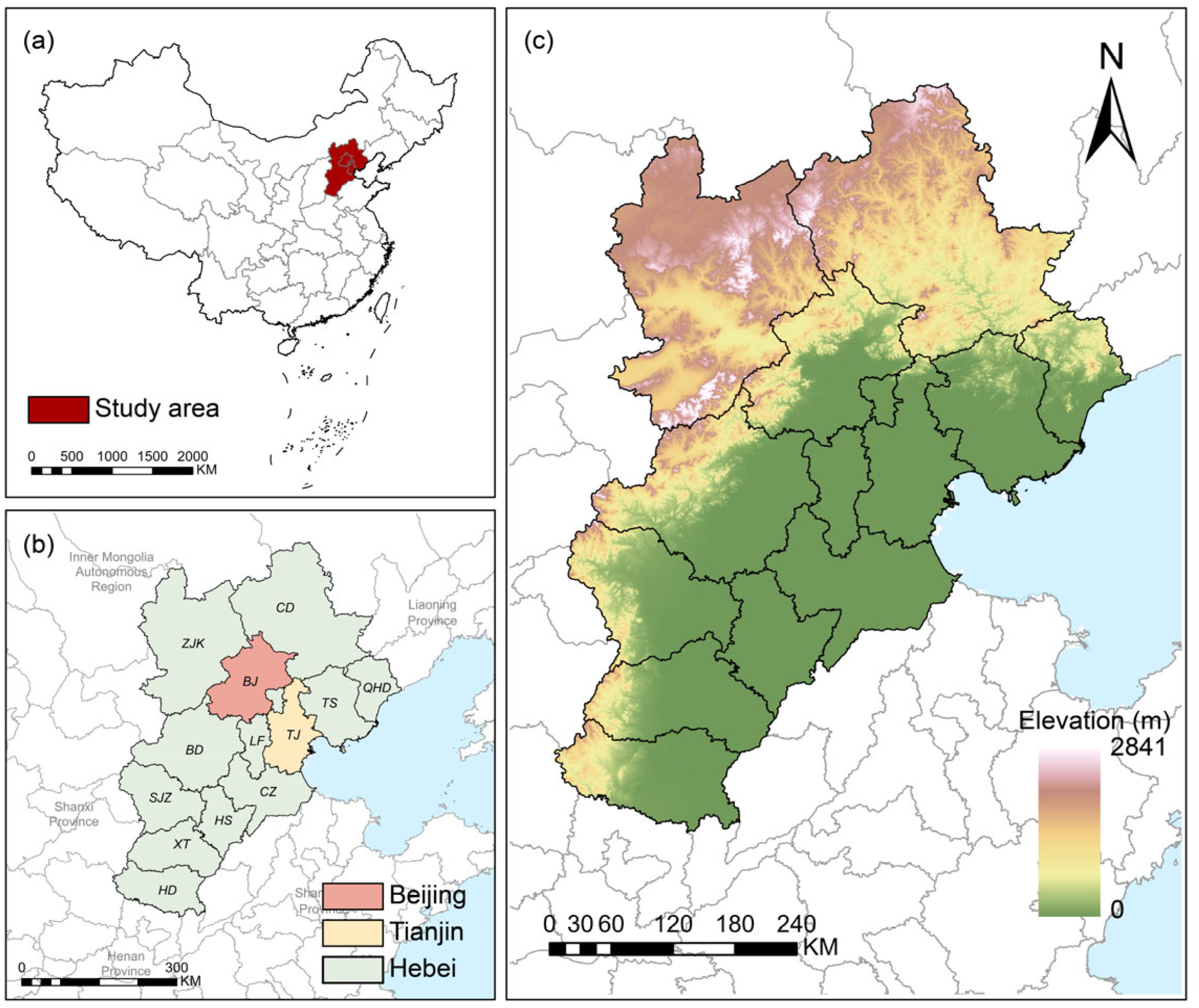
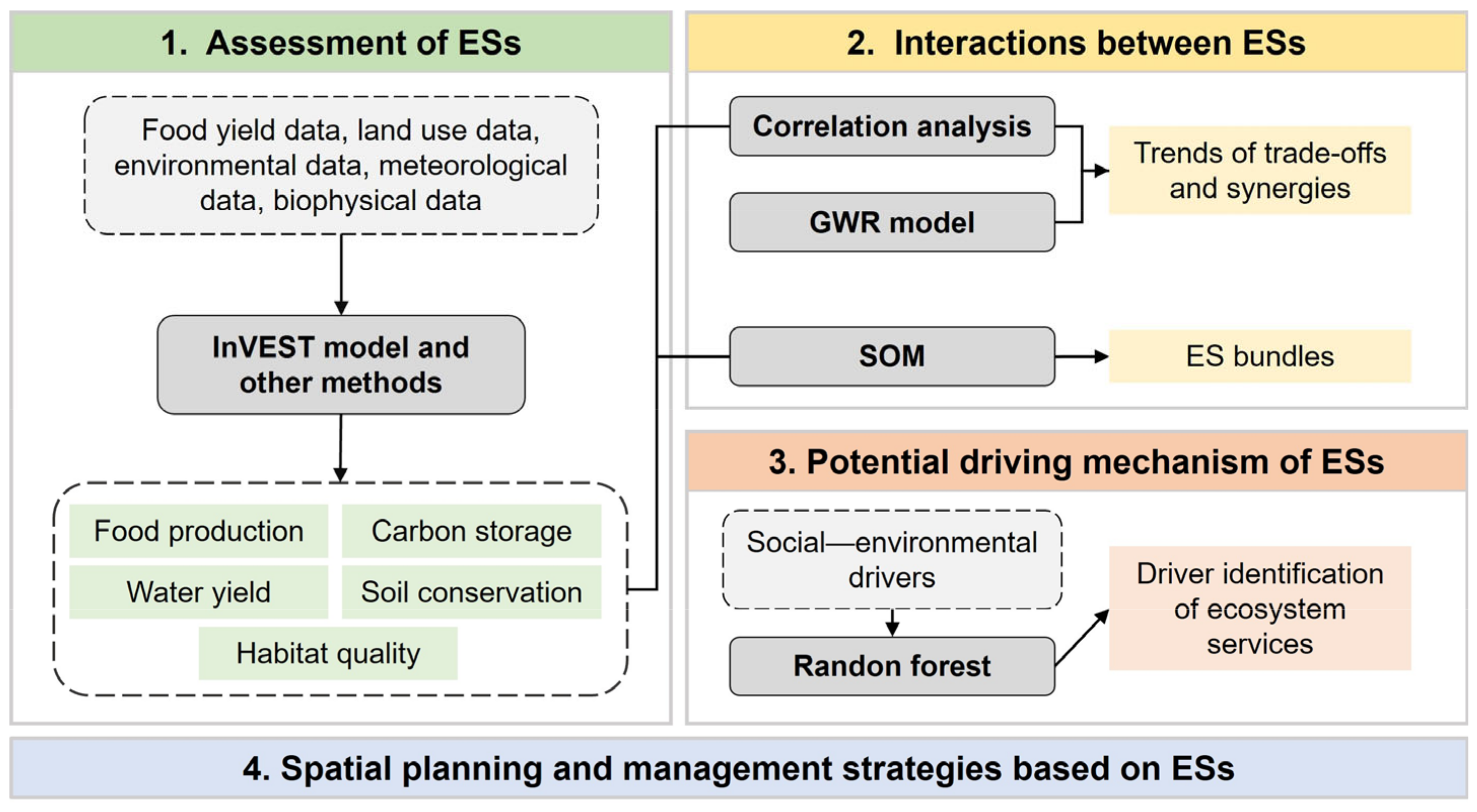
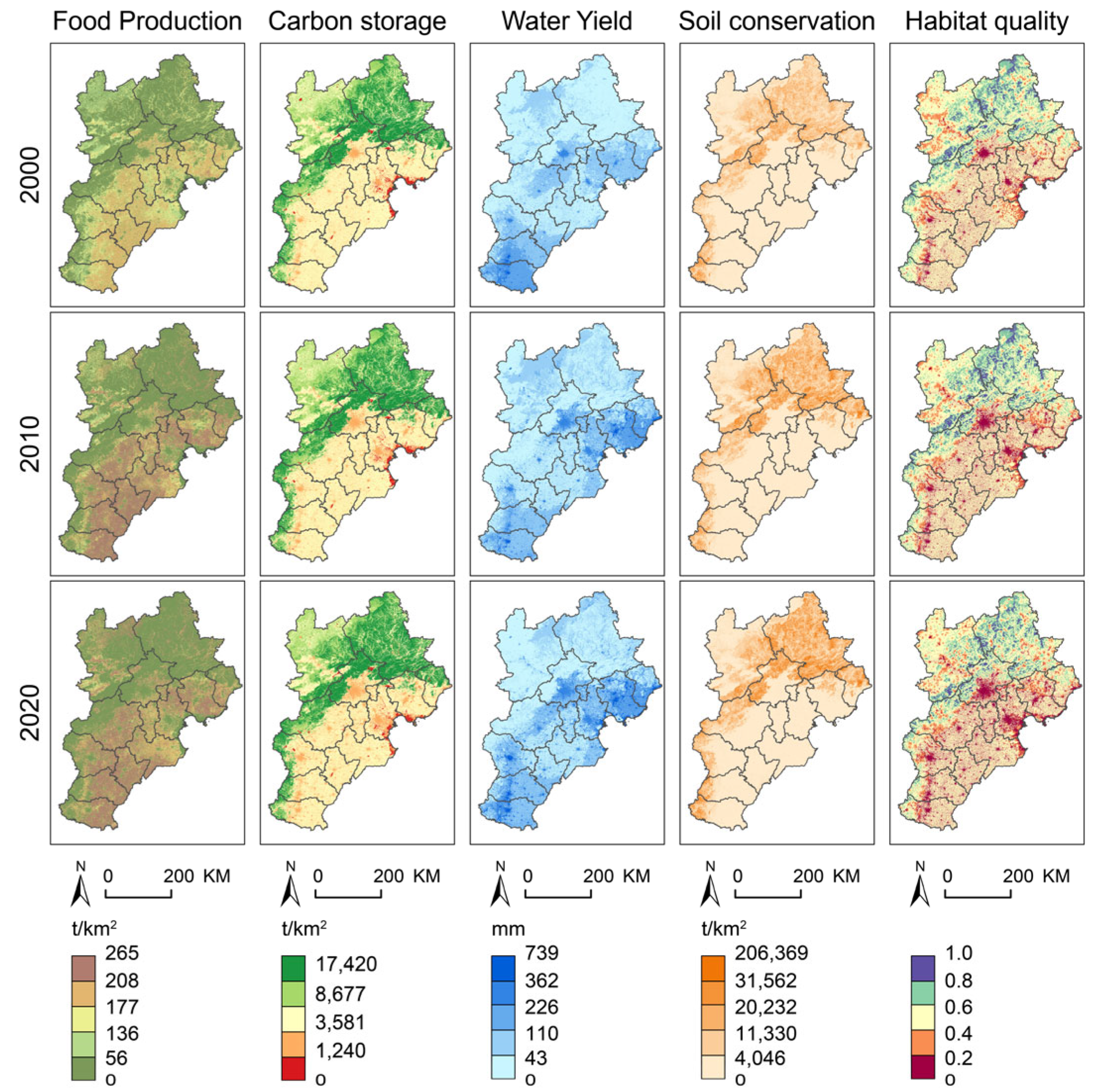
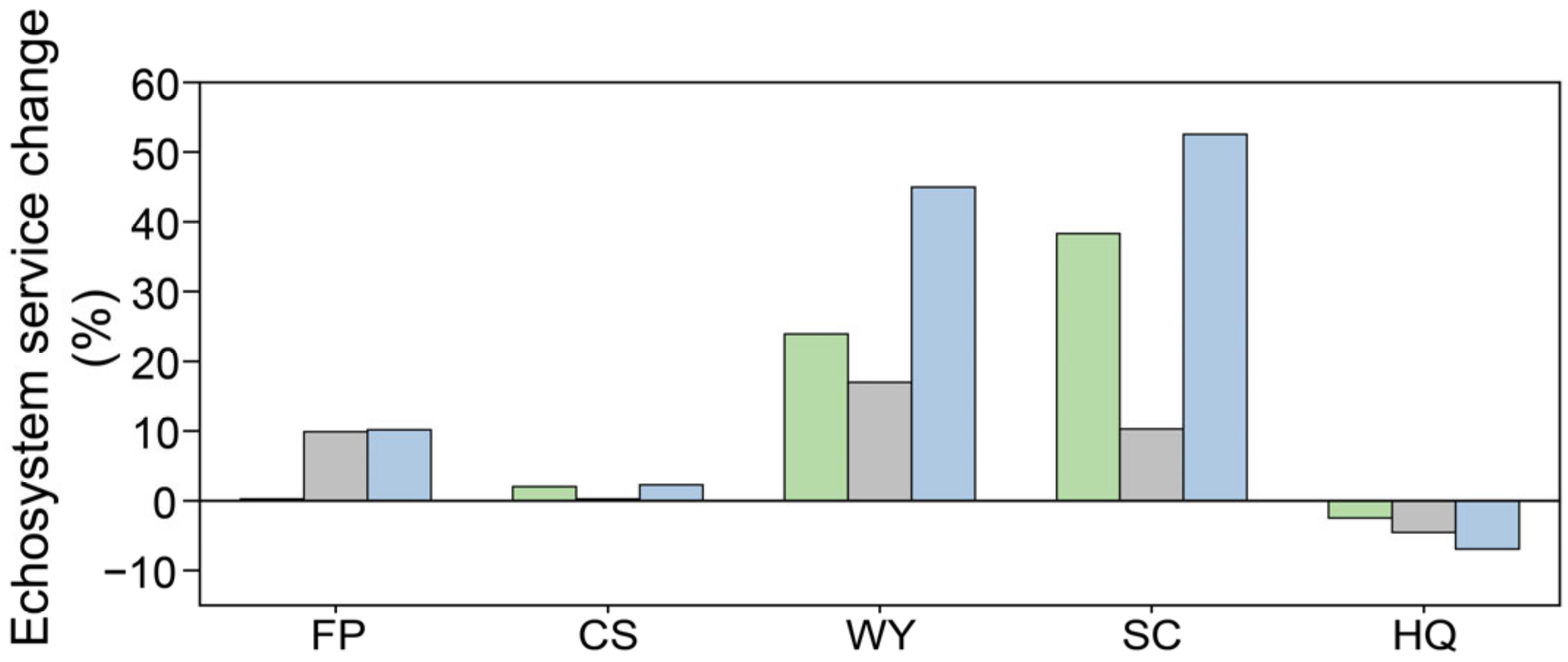

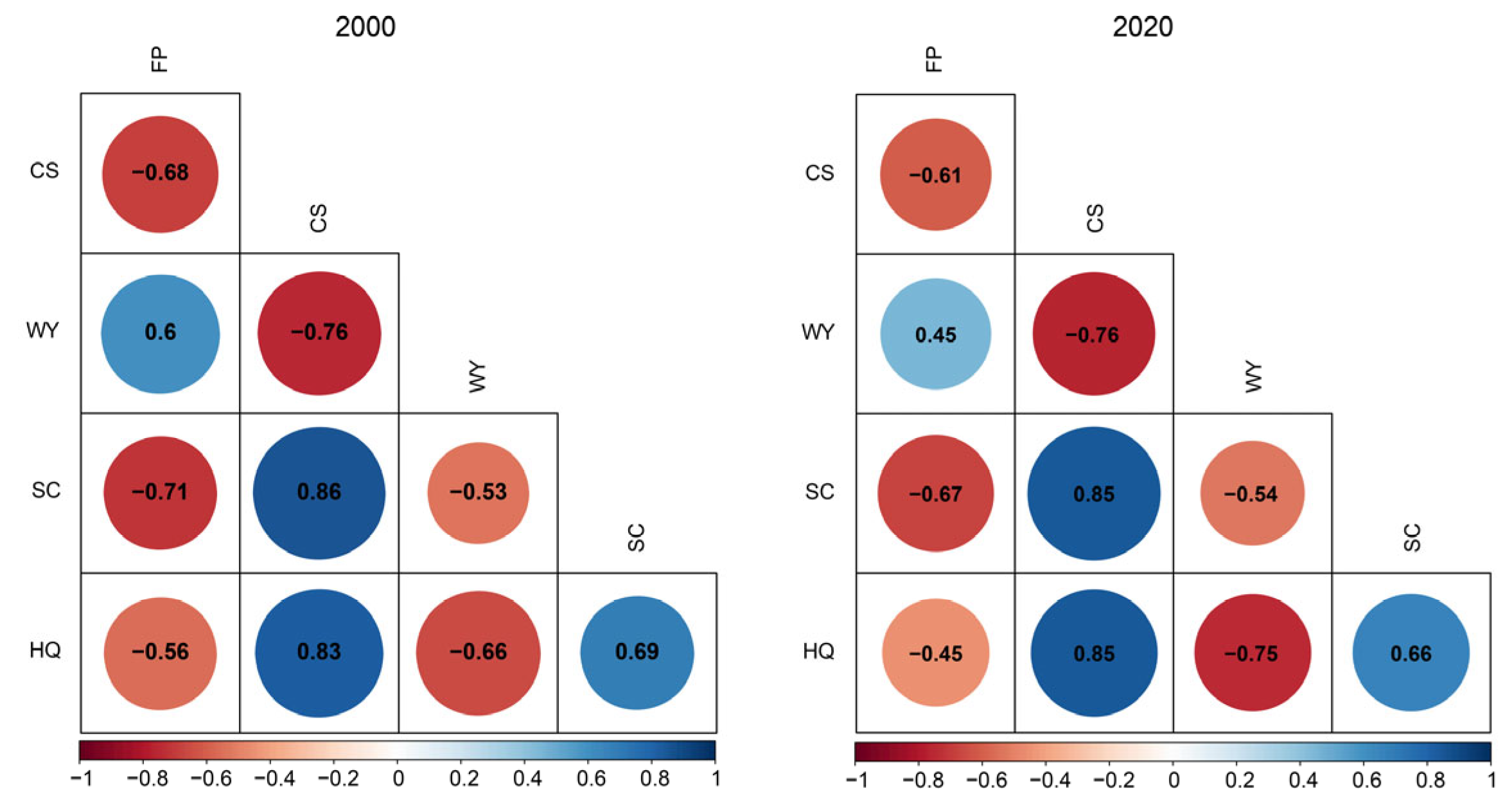



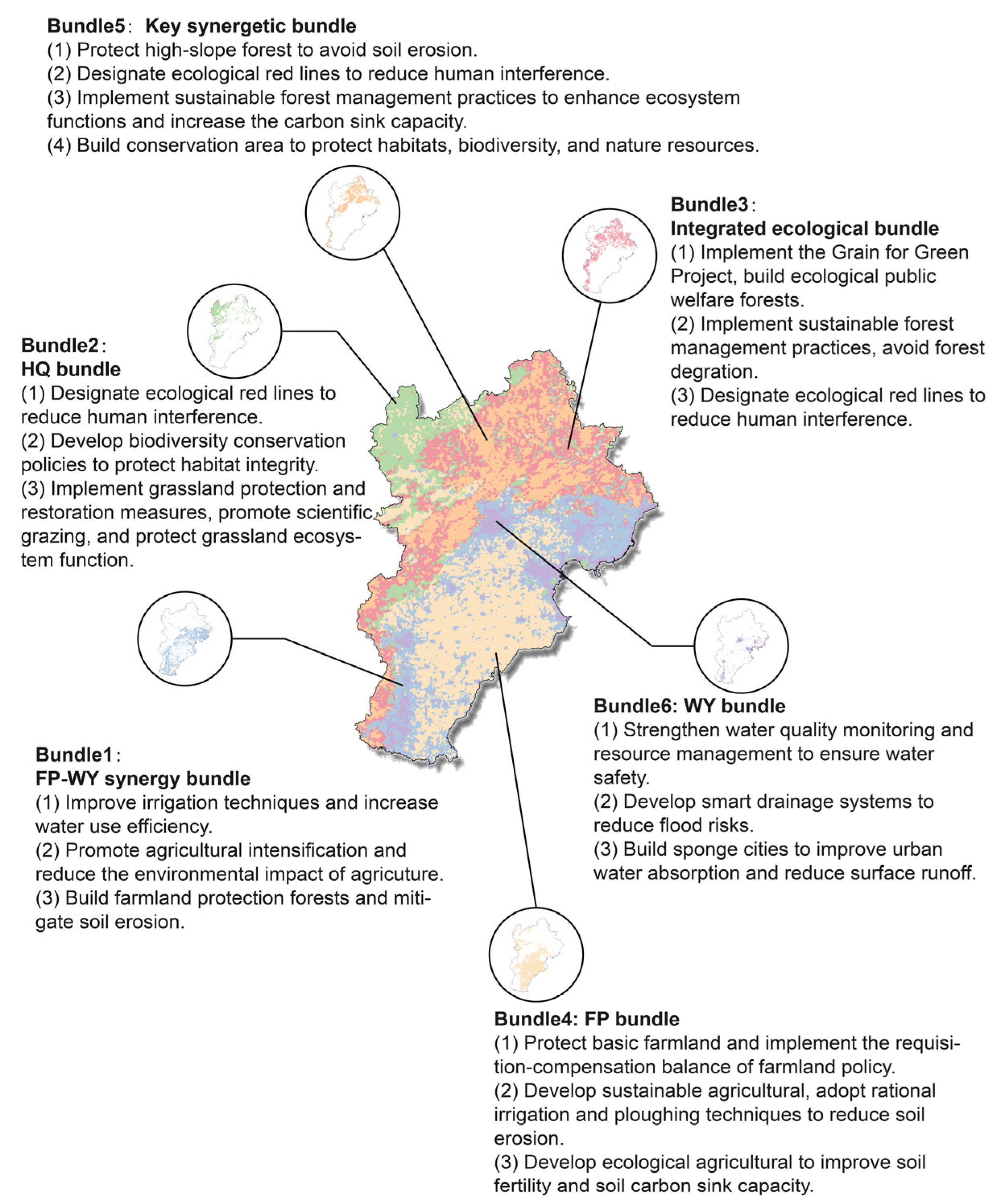
| Data Name | Application | Spatial Resolution | Data Source |
|---|---|---|---|
| Land use type | FP, CS, WY, SC, HQ | 30 m | China Land Cover Dataset [60] |
| Population | SED | 1 km | Land Scan Global (https://landscan.ornl.gov/, accessed on 26 March 2025) |
| GDP | SED | Resource and Environment Science and Data Center (http://www.resdc.cn/, accessed on 26 March 2025) | |
| Nightlight | SED | A Prolonged Artificial Nighttime Light Dataset of China (1984–2020) [61] 1 km monthly precipitation dataset for China (1901–2023) [62] 1 km monthly mean temperature dataset for China (1901–2023) [62] 1 km monthly potential evapotranspiration dataset for China (1901–2023) [63] | |
| Precipitation | WY, SC, SED | ||
| Temperature | SED | ||
| Evapotranspiration | WY | ||
| Normalized Difference Vegetation Index (NDVI) | FP, SED | 30 m | National Ecosystem Science Data Center (http://www.nesdc.org.cn/, accessed on 26 March 2025) |
| Digital elevation model (DEM) | SC | 30 m | The Geospatial Data Cloud (https://www.gscloud.cn/, accessed on 26 March 2025) |
| Fractional Vegetation Cover (FVC) | SED | 250 m | National Tibetan Plateau Data Center (https://data.tpdc.ac.cn/, accessed on 26 March 2025) |
| Root depth, soil texture, and organic carbon content | SC | 1 km | China soil map-based harmonized world soil database (HWSD) (v1.1) (http://data.tpdc.ac.cn/zh-hans/data/611f7d50-b419-4d14-b4dd-4a944b141175/, accessed on 26 March 2025) |
| Food yield | FP | Province | China Statistical Yearbook (https://www.stats.gov.cn/sj/ndsj/2020/indexch.htm, accessed on 26 March 2025) |
| Category | Driving Factor | Unit |
|---|---|---|
| Natural factors | Precipitation (X1) | mm |
| Temperature (X2) | °C | |
| FVC (X3) | % | |
| Social factors | Nightlight (X4) | Dimensionless |
| Population density (X5) | People/km2 | |
| GDP (X6) | Ten thousand yuan/km2 | |
| Land use factors | Cropland area ratio (X7) | % |
| Forest area ratio (X8) | % | |
| Grassland area ratio (X9) | % | |
| Impervious area ratio (X10) | % |
Disclaimer/Publisher’s Note: The statements, opinions and data contained in all publications are solely those of the individual author(s) and contributor(s) and not of MDPI and/or the editor(s). MDPI and/or the editor(s) disclaim responsibility for any injury to people or property resulting from any ideas, methods, instructions or products referred to in the content. |
© 2025 by the authors. Licensee MDPI, Basel, Switzerland. This article is an open access article distributed under the terms and conditions of the Creative Commons Attribution (CC BY) license (https://creativecommons.org/licenses/by/4.0/).
Share and Cite
Hu, Y.; Xu, X.; Huang, X.; Li, Y.; Cao, J.; Yan, Y.; Hu, X.; Wu, S. Urban Spatial Management and Planning Based on the Interactions Between Ecosystem Services: A Case Study of the Beijing–Tianjin–Hebei Urban Agglomeration. Remote Sens. 2025, 17, 1258. https://doi.org/10.3390/rs17071258
Hu Y, Xu X, Huang X, Li Y, Cao J, Yan Y, Hu X, Wu S. Urban Spatial Management and Planning Based on the Interactions Between Ecosystem Services: A Case Study of the Beijing–Tianjin–Hebei Urban Agglomeration. Remote Sensing. 2025; 17(7):1258. https://doi.org/10.3390/rs17071258
Chicago/Turabian StyleHu, Yue, Xixi Xu, Xuening Huang, Ying Li, Jiaxi Cao, Yimeng Yan, Xiaodan Hu, and Shuhong Wu. 2025. "Urban Spatial Management and Planning Based on the Interactions Between Ecosystem Services: A Case Study of the Beijing–Tianjin–Hebei Urban Agglomeration" Remote Sensing 17, no. 7: 1258. https://doi.org/10.3390/rs17071258
APA StyleHu, Y., Xu, X., Huang, X., Li, Y., Cao, J., Yan, Y., Hu, X., & Wu, S. (2025). Urban Spatial Management and Planning Based on the Interactions Between Ecosystem Services: A Case Study of the Beijing–Tianjin–Hebei Urban Agglomeration. Remote Sensing, 17(7), 1258. https://doi.org/10.3390/rs17071258






